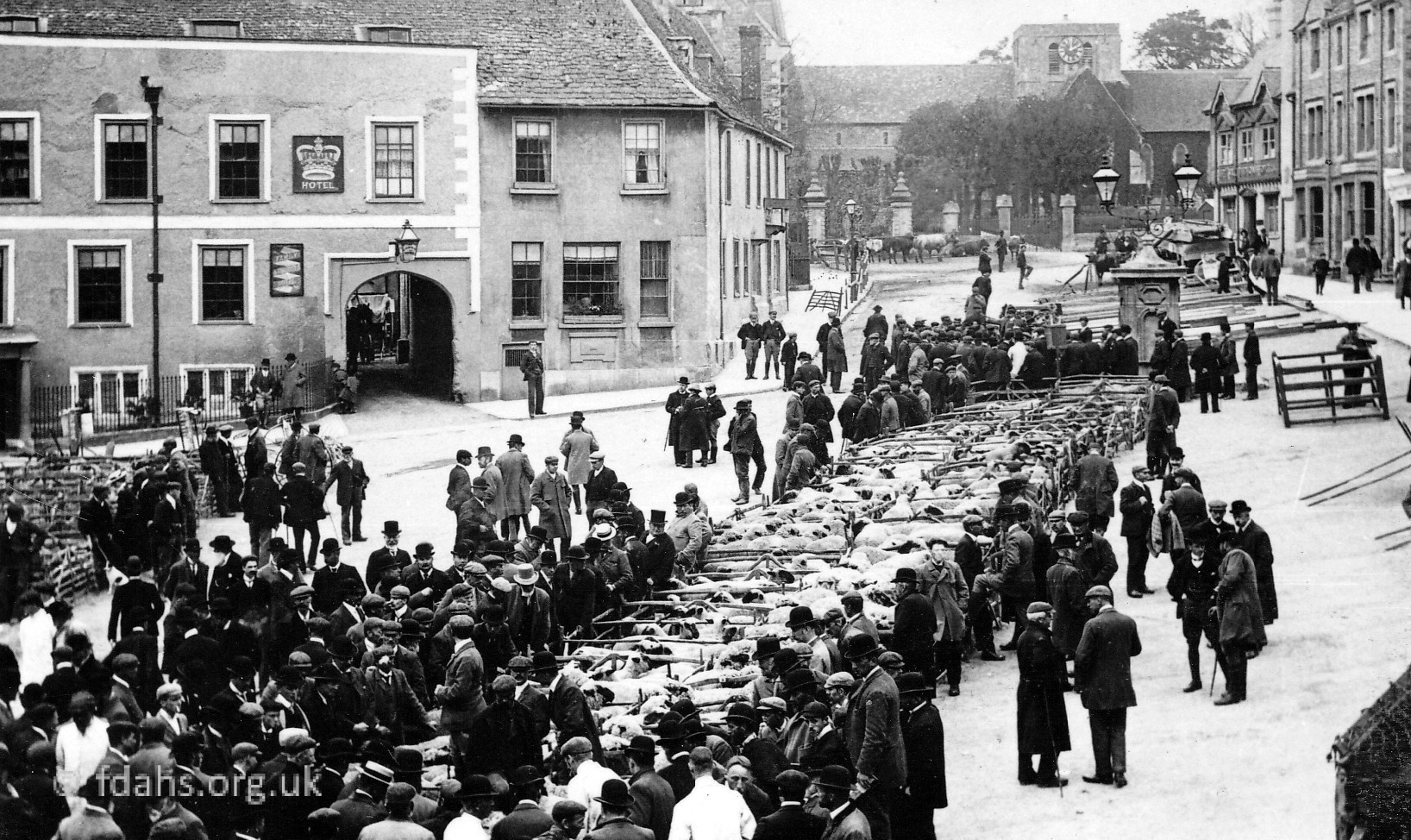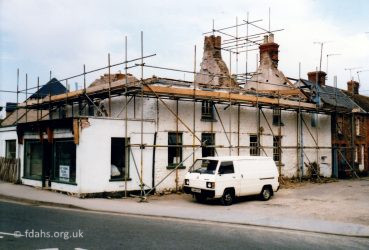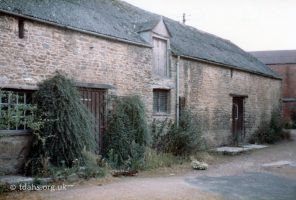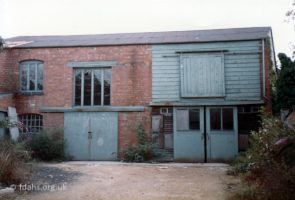 Gloucester Street heads west from the town centre of Faringdon. It was once the main road to Gloucester via Lechlade.
Gloucester Street heads west from the town centre of Faringdon. It was once the main road to Gloucester via Lechlade.
See Gloucester Street Shops & Businesses for a brief history of occupation.
Also see our house by house tour of Gloucester Street in the Year 2000.
See Faringdon Streets for an indexed list of all streets in Faringdon.
Views of Gloucester Street in the 18/1900s
c1910s & 1982. The top of Gloucester Street looking towards the town centre with Lechlade Road to the left and Gravel Walk to the right. The corner of the building on the left in the older photo was the shop-front of Thomas Hicks the bakers #56 (see next four photos). Here was the entrance to Parsonage Lane, Pound Close, and College Row, which no longer exist. Next are 4 terraced houses #38-32. The old barn next door later became Price’s motor cycle showroom. The wooden gate is now a metal gate at the main entrance to Faringdon Junior School behind.
 c1950s. The same place at the top of Gloucester Street looking towards the town centre with Lechlade Road to the left and Gravel Walk to the right. On the left is the shop-front of #56 Thomas Hicks the bakers and general store. Almost hidden behind the shop are the 4 terraced houses #38-32 shown in the first two photos. The next two low buildings are Price’s motor cycle showroom (later part of Enterprise Garage group) run by Maurice Musselwhite, now demolished. It was replaced by #30 Elms Veterinary Surgery and #28 a private house or flats. The jeep is parked outside the gated path to Faringdon Junior School behind. The next house #26, with the high dark roof and tiny window, was the home of Mr Liles the piano tuner. This later became a hairdresser’s run by Eileen Gibbs, and is now a private house. Then #24 the Elms School, with the lower headmistress’ house just before it ,and #22 Faringdon County Library jutting out to the left of the trees. The last house past the trees is Elmside now converted to flats.
c1950s. The same place at the top of Gloucester Street looking towards the town centre with Lechlade Road to the left and Gravel Walk to the right. On the left is the shop-front of #56 Thomas Hicks the bakers and general store. Almost hidden behind the shop are the 4 terraced houses #38-32 shown in the first two photos. The next two low buildings are Price’s motor cycle showroom (later part of Enterprise Garage group) run by Maurice Musselwhite, now demolished. It was replaced by #30 Elms Veterinary Surgery and #28 a private house or flats. The jeep is parked outside the gated path to Faringdon Junior School behind. The next house #26, with the high dark roof and tiny window, was the home of Mr Liles the piano tuner. This later became a hairdresser’s run by Eileen Gibbs, and is now a private house. Then #24 the Elms School, with the lower headmistress’ house just before it ,and #22 Faringdon County Library jutting out to the left of the trees. The last house past the trees is Elmside now converted to flats.
 1920s. Thomas Hicks and his wife ran the bakery and shop in front until very elderly, when their son Henry took it over. The lady in the doorway in this photo is Lou Townsend, later Louie McCabe who worked for Mr and Mrs Hicks. (In the 1960/70s Henry & Joyce Hicks took over Oxford House at #6 Marlborough Street. They had a washeteria to the left and a bakers shop to the right).
1920s. Thomas Hicks and his wife ran the bakery and shop in front until very elderly, when their son Henry took it over. The lady in the doorway in this photo is Lou Townsend, later Louie McCabe who worked for Mr and Mrs Hicks. (In the 1960/70s Henry & Joyce Hicks took over Oxford House at #6 Marlborough Street. They had a washeteria to the left and a bakers shop to the right).
Some memories of the bakers shop in Gloucester Street from local people: “We visited the shop daily in the 50s and 60s for our groceries and fresh cakes. Mr Hicks made amazing doughnuts in his bakery there and allowed us to add extra jam.” “Mr Hicks (Tom I think ?) could cut a slice from a huge round cheese with his slice wire to exactly the weight you wanted, no scales required. He also charmed my warts away.” “Mr Hicks spat on my wart on my thumb said some mumbo jumbo, told me to bury some bacon in the garden and forget about it, I did and it went!!! That was real magic to me as a child in the fifties also the broken biscuits too.”
1988 & 2000. Repair and conversion into flats of Hicks old bakery and shop at the junction of Gloucester Street and Lechlade Road. The shop at the front was demolished and is now a front garden. The two lower windows to the right were removed and there is now an arch-way providing access to the rear.
 There is a small lane off to the right of the old bakery which used to be known as College Row but recently has become part of Gloucester Street. It is a row of houses, which leads to the back entrance of what is now the Elms Primary School. In deeds of the 17th and 18th century it was referred to as Pound Close, probably after the pound where stray animals were kept, which was nearby. Then in a deed of 1876 it is referred to as Parsonage Lane, which could be connected to its proximity to the Wesleyan Chapel across the road.
There is a small lane off to the right of the old bakery which used to be known as College Row but recently has become part of Gloucester Street. It is a row of houses, which leads to the back entrance of what is now the Elms Primary School. In deeds of the 17th and 18th century it was referred to as Pound Close, probably after the pound where stray animals were kept, which was nearby. Then in a deed of 1876 it is referred to as Parsonage Lane, which could be connected to its proximity to the Wesleyan Chapel across the road.
 Opposite Hicks old bakery, still on the end of Gloucester Street and College Row (to the left). Gravel Walk is to the right and Lechlade Road behind. The stone building behind the red brick one is the Masonic Hall, which they took over in 1921 from the Wesleyan Methodists.
Opposite Hicks old bakery, still on the end of Gloucester Street and College Row (to the left). Gravel Walk is to the right and Lechlade Road behind. The stone building behind the red brick one is the Masonic Hall, which they took over in 1921 from the Wesleyan Methodists.
 c1910. Further down at the middle of Gloucester Street. Behind the tree to the left and off photo is now the library. Behind the library is the ‘Town Park’, activities held there were mentioned frequently in local newspapers in 1916. The building seen under the tree is Elmside, which was demolished and rebuilt in 1989. The larger building further down on the left is what was then Porter’s Corn & Seed Store, later taken over by Langford – see below.
c1910. Further down at the middle of Gloucester Street. Behind the tree to the left and off photo is now the library. Behind the library is the ‘Town Park’, activities held there were mentioned frequently in local newspapers in 1916. The building seen under the tree is Elmside, which was demolished and rebuilt in 1989. The larger building further down on the left is what was then Porter’s Corn & Seed Store, later taken over by Langford – see below.

 1989 & c2000. Elmside (#22 Gloucester Street) was used for wedding receptions and parties in the 1970s and 80s. It was then demolished in 1989 and rebuilt as the private flats shown in these photographs.
1989 & c2000. Elmside (#22 Gloucester Street) was used for wedding receptions and parties in the 1970s and 80s. It was then demolished in 1989 and rebuilt as the private flats shown in these photographs.
 1953. Nearer the bottom of Gloucester Street looking towards the Corn Market, Langford’s (previously Porter’s) Corn Stores, on the left, was originally a barn belonging to a farm with the dairy on the opposite side of the road. Seeds, gardening items, pet foods, etc. were sold there. John Edmonds managed the business and then bought it, but kept the old name. Some time after 1995 it was converted into flats and called Langford House #12-10. Further down, #8 Gloucester House, the dentist’s surgery at the back, is fronted by trees and bushes. It is thought that this was the old farm house of the farm that stood there many years ago. Further along is the cinema where once stood some barns and old cottages belonging to the farm. Where the first sunblind is protruding is Taylor & Sons (butcher & slaughter house) at #6 Cornmarket then White Bros. (hairdressing establishment and tobacconist) at #7 Cornmarket with the second sunblind. At the end of the street can be seen the fishmonger’s shop belonging to Taylor & Sons at #1 Cornmarket.
1953. Nearer the bottom of Gloucester Street looking towards the Corn Market, Langford’s (previously Porter’s) Corn Stores, on the left, was originally a barn belonging to a farm with the dairy on the opposite side of the road. Seeds, gardening items, pet foods, etc. were sold there. John Edmonds managed the business and then bought it, but kept the old name. Some time after 1995 it was converted into flats and called Langford House #12-10. Further down, #8 Gloucester House, the dentist’s surgery at the back, is fronted by trees and bushes. It is thought that this was the old farm house of the farm that stood there many years ago. Further along is the cinema where once stood some barns and old cottages belonging to the farm. Where the first sunblind is protruding is Taylor & Sons (butcher & slaughter house) at #6 Cornmarket then White Bros. (hairdressing establishment and tobacconist) at #7 Cornmarket with the second sunblind. At the end of the street can be seen the fishmonger’s shop belonging to Taylor & Sons at #1 Cornmarket.
 Early 1900s. Turning around and looking back up the street is a much earlier view from the bottom of Gloucester Street. On the right is Frederick Porter’s Corn & Seed Store 1895 to 1915, which by 1931 was taken over by Mr R. Langford. The ivy covered house is #8 Gloucester House. It is thought that this was the old farm house of the farm that stood there many years ago and previously Cistercian monks had a priory on this site.
Early 1900s. Turning around and looking back up the street is a much earlier view from the bottom of Gloucester Street. On the right is Frederick Porter’s Corn & Seed Store 1895 to 1915, which by 1931 was taken over by Mr R. Langford. The ivy covered house is #8 Gloucester House. It is thought that this was the old farm house of the farm that stood there many years ago and previously Cistercian monks had a priory on this site.
 1890s. People waiting for something to happen outside the Volunteer Inn. The roof and chimneys of Gloucester House are on the far left. Then a barn or old cottage that was once part of the farm mentioned above, and demolished in 1935 to build the Rialto Cinema. The corner of the building on the right would have been Taylor & Sons, a butcher & slaughter house, at this time and was addressed as #6 Corn Market.
1890s. People waiting for something to happen outside the Volunteer Inn. The roof and chimneys of Gloucester House are on the far left. Then a barn or old cottage that was once part of the farm mentioned above, and demolished in 1935 to build the Rialto Cinema. The corner of the building on the right would have been Taylor & Sons, a butcher & slaughter house, at this time and was addressed as #6 Corn Market.
 1898. Turning around to look at the bottom of Gloucester Street towards the Corn Market with the Volunteer Inn on the left and the Corn Exchange on the right. The rest of the photo is in the Corn Market. Next to the inn is Taylor & Sons, a butcher & slaughter house at #6 Corn Market. The large white building sticking out is #7, which would have been Yeatman’s sweets shop at this time. Across the road with the clock and gas lamp at #2 is Counsell Jewellers, which was established in the 1890s.
1898. Turning around to look at the bottom of Gloucester Street towards the Corn Market with the Volunteer Inn on the left and the Corn Exchange on the right. The rest of the photo is in the Corn Market. Next to the inn is Taylor & Sons, a butcher & slaughter house at #6 Corn Market. The large white building sticking out is #7, which would have been Yeatman’s sweets shop at this time. Across the road with the clock and gas lamp at #2 is Counsell Jewellers, which was established in the 1890s.
1983. Finally, on the other side of the street, is the side entrance to the back of the Corn Exchange, which was built in 1863. The lower building next door was built at the same time to be a Savings Bank and was soon taken over by the Freemasons. It has since been used as offices for the Town Council and as the Tourist Information Centre. The entrance at the side, before the red brick building at No 3 Gloucester Street, used to lead to G. Roberts Ltd Farm Supplies. The last two photos show the old buildings in Roberts Yard. These used to be the stables at the back of the Green Dragon Coaching Inn, which was demolished when the Corn Exchange was built on the site in 1863. The old stables remained there until they were demolished in the 1980’s in order to build a cul-de-sac of new houses called Gloucester Mews.
Reference:
The Changing Faces of Faringdon and Surrounding Villages – Bk1 p15-17. By Rosemary Church, Jim Brown, Millie Bryan and Beryl Newman. Robert Boyd Publications. Now out of print.
Researched by Ian Lee, January 2020.







